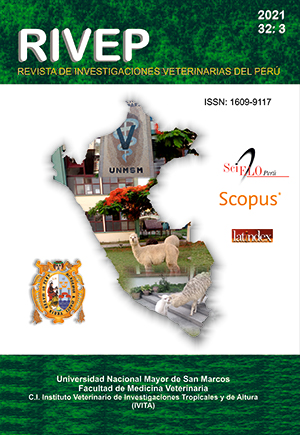Dynamic spatio-temporal of the aerial biomass in high Andean grasslands based on NDVI-MODIS validated by spectrometry in situ
DOI:
https://doi.org/10.15381/rivep.v32i3.20392Keywords:
vegetation index, high grassland, low grassland, satellite imagesAbstract
Moderate resolution imagery (MODIS) data from the Normalized Difference Vegetation Index (NDVI) can be used to estimate aboveground biomass at large spatial scales; however, validation of the information with fieldwork is required to make more accurate grassland vegetation predictions. The study was conducted in three districts of the central highlands of Peru. In total, 153 grass samples (high grassland and low grassland) were collected after reading NDVI in situ within a pixel of 250x250 m, with a frequency of three months during a three year period. Satellite images were downloaded from the MODIS sensor to obtain the NDVI. The NDVI-MODIS values were calibrated with the NDVI registered in situ, using regression models. The calibrated equations modelled the dynamic trends of vegetation between 2000 and 2018 for the central highlands. The NDVI in situ of the low grassland ranged between 0.36 ± 0.13 and 0.24 ± 0.05 in the wet and dry seasons, respectively, while the high grassland ranged between 0.42 ± 0.14 and 0.26 ± 0.10 in the wet and dry seasons, respectively. The NDVI of the MODIS sensor for the low grassland ranged between 0.41 ± 0.14 and 0.27 ± 0.06 in the wet and dry seasons, respectively, and for the high grassland between 0.44 ± 0.14 and 0.41 ± 0.10 in the wet and dry seasons, respectively. The quadratic model obtained better estimators both for the NDVI calibration (RMSE: 0.06 and R2: 0.91) and for the biomass prediction (RMSE: 1300 and R2: 0.61). It is concluded that it is possible to use satellite information to evaluate the high Andean grasslands.
Downloads
Downloads
Published
Issue
Section
License
Copyright (c) 2021 Jimny Nuñez Delgado, Samuel Pizarro Carcausto, Marco Gutiérrez Tang, Javier Ñaupari Vásquez

This work is licensed under a Creative Commons Attribution 4.0 International License.
AUTHORS RETAIN THEIR RIGHTS:
a. Authors retain their trade mark rights and patent, and also on any process or procedure described in the article.
b. Authors retain their right to share, copy, distribute, perform and publicly communicate their article (eg, to place their article in an institutional repository or publish it in a book), with an acknowledgment of its initial publication in the Revista de Investigaciones Veterinarias del Perú (RIVEP).
c. Authors retain theirs right to make a subsequent publication of their work, to use the article or any part thereof (eg a compilation of his papers, lecture notes, thesis, or a book), always indicating the source of publication (the originator of the work, journal, volume, number and date).



